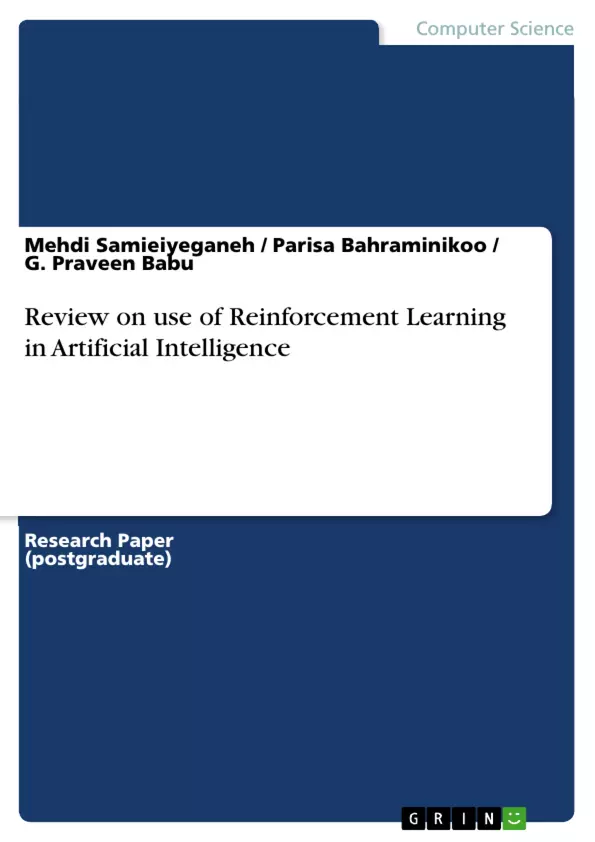Human started
making machinery that can do the job for them. The
technology developed so much that it started involving
many other branches of engineering such as electronics,
robotics etc. This eventually led to much more complex
and smart machinery involving Artificial Intelligence.
Reinforcement Learning is a type of Machine Learning,
and thereby also a branch of Artificial Intelligence. It
allows machines and software agents to automatically
determine the ideal behavior within a specific context, in
order to maximize its performance. Reinforcement
Learning (RL) comes from the animal learning theory.
RL does not need prior knowledge, it can autonomously
get optional policy with the knowledge obtained by trial-
and-error and continuously interact with dynamic
environment.
As a matter of fact, Reinforcement Learning is defined by
a specific type of problem, and all its solutions are classed
as Reinforcement Learning algorithms. In the problem,
an agent is supposed decide the best action to select based
on its current state. When this step is repeated, the
problem is known as a Markov Decision Process.
A Markov Decision Process is a discrete time stochastic
control process. At each time step, the process is in some
state s, and the decision maker may choose any action
that is available in state‘s’. Markov Decision Process
provides a mathematical framework for modeling
decision-making in situations where outcomes are partly
random and partly under the control of a decision maker.
Inhaltsverzeichnis (Table of Contents)
- I. INTRODUCTION
- A. Definition
- II. ARTIFICIAL INTELLIGENCE
- A. Definition
- B. Application of AI in the Business World
- III. REINFORCEMENT LEARNING
- A. Definition
- B. Limitations
- C. Applications
- D. Examples
- IV. CONCLUSION
Zielsetzung und Themenschwerpunkte (Objectives and Key Themes)
This paper explores the application of Reinforcement Learning (RL) in Artificial Intelligence (AI). It provides a concise overview of both AI and RL, highlighting their respective definitions, key features, and applications. The paper examines the development and history of AI, its influence on various sectors, and the potential impact of future advancements. It also delves into the principles, benefits, and limitations of RL, exploring how RL algorithms can enable machines to learn optimal behaviors through interaction with their environment. Key themes covered in this paper include:- The history and evolution of Artificial Intelligence.
- The role of Reinforcement Learning as a branch of Machine Learning within AI.
- The applications of Reinforcement Learning in various fields, including robotics, game playing, and process control.
- The challenges and limitations of Reinforcement Learning research.
- The potential impact of Artificial Intelligence and Reinforcement Learning on the future of technology and society.
Zusammenfassung der Kapitel (Chapter Summaries)
I. INTRODUCTION
This introductory section lays the foundation by establishing the context of AI and its historical roots. It traces the origins of AI to the work of Alan Turing and emphasizes its evolution as a field of computer science focused on creating intelligent machines. The section introduces the concept of Reinforcement Learning as a specific type of Machine Learning and a key element within the broader field of AI.II. ARTIFICIAL INTELLIGENCE
This chapter provides a comprehensive overview of Artificial Intelligence. It defines AI as the branch of computer science aiming to develop machines capable of exhibiting human-like intelligence. It highlights key areas of AI, such as game playing, expert systems, and natural language processing. The chapter also examines the potential impact of AI on business operations and the future of work.III. REINFORCEMENT LEARNING
This chapter focuses on Reinforcement Learning, a powerful technique for enabling machines to learn optimal behaviors through trial and error. The section defines RL and explains its core principles: an agent interacting with an environment, receiving rewards or punishments based on its actions, and learning to maximize its rewards over time. It discusses the challenges of RL research, such as the need for efficient value estimation and the handling of complex, modular problems. The chapter concludes by showcasing the wide range of applications for RL, from controlling robotic arms to scheduling elevators.Schlüsselwörter (Keywords)
This paper focuses on the intersection of Artificial Intelligence, Machine Learning, and Reinforcement Learning. It explores key concepts such as intelligent agents, decision-making, reward maximization, and the potential impact of these technologies on society. The paper highlights the applications of Reinforcement Learning in fields like robotics, game playing, and process control.- Quote paper
- Mehdi Samieiyeganeh (Author), Parisa Bahraminikoo (Author), G. Praveen Babu (Author), 2012, Review on use of Reinforcement Learning in Artificial Intelligence, Munich, GRIN Verlag, https://www.hausarbeiten.de/document/195798


